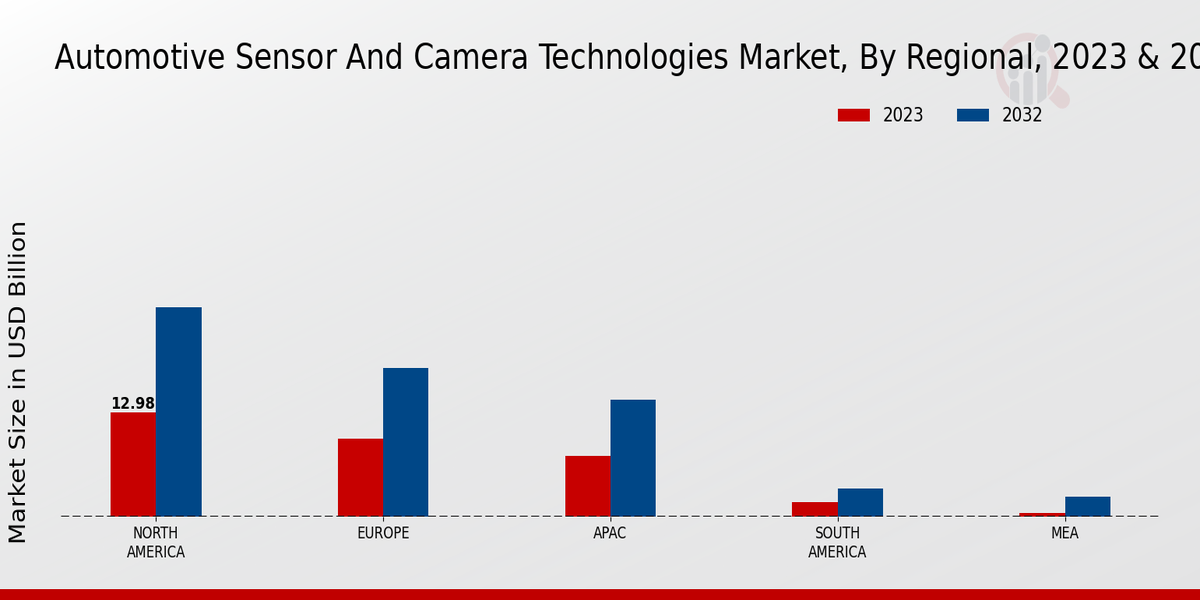Market Growth Projections
The Global Automotive Sensor and Camera Technologies Market Industry is poised for substantial growth, with projections indicating a market size of 38.3 USD Billion in 2024 and an anticipated increase to 88.4 USD Billion by 2035. This growth trajectory suggests a robust compound annual growth rate (CAGR) of 7.91% from 2025 to 2035. Such figures reflect the increasing integration of advanced sensor and camera technologies in vehicles, driven by consumer demand for enhanced safety and automation features. The market's expansion is indicative of broader trends in the automotive industry, where technological advancements and regulatory pressures are reshaping the landscape.
Growth of Electric and Autonomous Vehicles
The rise of electric and autonomous vehicles significantly influences the Global Automotive Sensor and Camera Technologies Market Industry. As the automotive landscape shifts towards electrification and automation, the demand for sophisticated sensor and camera systems increases. These technologies are essential for enabling autonomous driving capabilities, which rely on accurate environmental perception. The market's growth trajectory is likely to be bolstered by the anticipated expansion of electric and autonomous vehicle production, aligning with global sustainability goals. This transition is expected to create new opportunities for sensor and camera technology providers, further enhancing market dynamics.
Government Regulations and Safety Standards
Government regulations and safety standards play a crucial role in the Global Automotive Sensor and Camera Technologies Market Industry. Many countries are implementing stringent safety regulations that require the incorporation of advanced safety features in new vehicles. These regulations often mandate the use of specific sensor technologies to ensure compliance with safety standards. As a result, automotive manufacturers are increasingly investing in sensor and camera technologies to meet these requirements. This regulatory landscape is expected to drive market growth, as compliance becomes essential for market entry and competitiveness in the automotive sector.
Increasing Consumer Awareness of Vehicle Safety
Consumer awareness regarding vehicle safety is a significant driver for the Global Automotive Sensor and Camera Technologies Market Industry. As more individuals recognize the benefits of safety features, there is a corresponding increase in demand for vehicles equipped with advanced sensors and cameras. This trend is further supported by educational campaigns from automotive manufacturers and safety organizations, emphasizing the importance of ADAS. Consequently, the market is projected to expand, reaching 88.4 USD Billion by 2035. This heightened awareness not only influences purchasing decisions but also encourages manufacturers to prioritize safety technologies in their offerings.
Rising Demand for Advanced Driver Assistance Systems
The increasing emphasis on safety and automation in vehicles drives the Global Automotive Sensor and Camera Technologies Market Industry. Advanced Driver Assistance Systems (ADAS) utilize various sensors and cameras to enhance vehicle safety, thereby reducing accidents. In 2024, the market is projected to reach 38.3 USD Billion, reflecting a growing consumer preference for vehicles equipped with these technologies. Governments worldwide are also promoting regulations that mandate the inclusion of ADAS features, further propelling market growth. As a result, the integration of sensors and cameras in vehicles is becoming a standard expectation among consumers.
Technological Advancements in Sensor and Camera Technologies
Innovations in sensor and camera technologies are pivotal in shaping the Global Automotive Sensor and Camera Technologies Market Industry. Developments such as high-resolution cameras, LiDAR, and radar systems enhance vehicle perception and decision-making capabilities. These advancements enable features like lane-keeping assistance, adaptive cruise control, and automated parking. The continuous evolution of these technologies is expected to attract investments, with the market anticipated to grow at a CAGR of 7.91% from 2025 to 2035. This growth indicates a robust interest in integrating cutting-edge technologies into automotive applications, thereby enhancing overall vehicle performance and safety.






















